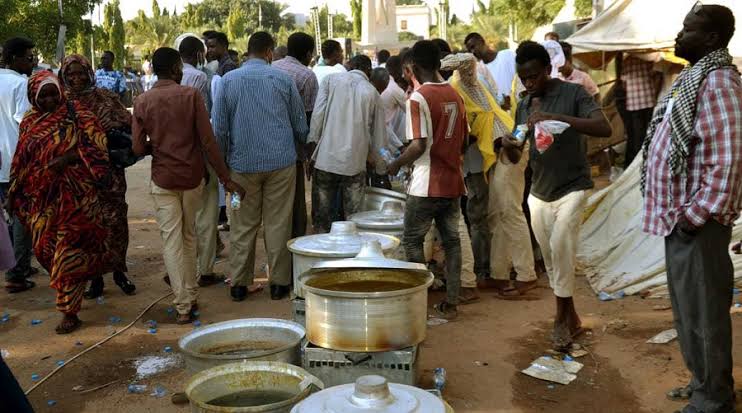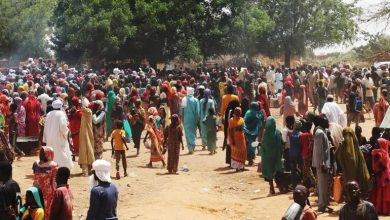Reports
The repercussions of the Sudan war…a frightening famine

Muzdalifah Muhammed Othman
Volunteers in emergency rooms, residents in various parts of Sudan, and witnesses involved in providing food through communal kitchens told “Sudan Tribune” that approximately 97 areas in the country have already been hit by famine. According to these reports, around 101 people have died from starvation.
The World Food Programme (WFP) has stated that Sudan is facing the largest hunger crisis in the world, with 25.6 million people “suffering from acute hunger.”
WFP spokesperson in Sudan, Leni Kinzli, confirmed to journalists last Friday in Geneva that this means 54% of the population is experiencing hunger.
She pointed out that one in two Sudanese cannot afford a basic daily meal and struggle every day just to find food.
Last Wednesday, the WFP announced that trucks carrying vital food supplies had crossed from Chad into Sudan via the Adré border crossing.
In a post on X (formerly Twitter), the WFP stated: “Trucks carrying vital food supplies from the World Food Programme have crossed the border from Chad into Sudan via the Adré border crossing.”
“Sudan Tribune” gathered testimonies from 19 humanitarian volunteers and residents across 11 states about the spread of famine in these regions, confirming its presence in 97 areas where they are located or nearby. They were unable to collect testimonies from three states – Blue Nile, Al Jazeera, and Sennar – due to internet and communication problems.
The United Nations’ Famine Review Committee recently reported that 13 additional areas are on the brink of famine, mostly in Darfur, Kordofan, Khartoum, and Al Jazeera.
Eating Tree Leaves
Famine surrounds the Zamzam camp. The situation for residents trapped in conflict zones, known as “hot zones” like Sennar State, south of Khartoum, north of Bahri, and some cities in Darfur, has become so dire that they rely on tree leaves as a source of food.
Famine has struck areas south of Khartoum up to Jabal Awliya and surrounding villages, which are under the control of the Rapid Support Forces (RSF). Thirteen people have recently died from hunger, according to members of emergency committees working in the area who spoke to “Sudan Tribune.”
Remaining residents in areas like Kalakla, Andalus, and Al-Inqadh are living in catastrophic conditions, receiving their only meal of the day from some communal kitchens, which occasionally shut down due to difficulties in receiving financial support from abroad.
Those remaining in Salama, Al-Azhari, Soba East, and Al-Daim neighborhoods are also suffering severe hardships due to the lack of food and medicine.
There are increasing calls from the United Nations and international bodies to end the war to avoid a humanitarian disaster in Sudan that could push millions towards famine and death due to food shortages caused by the ongoing conflict, which has spread to 13 out of the 18 states.
Volunteers in Bahri, who requested anonymity for security reasons, told “Sudan Tribune” that 49 people recently died from hunger in various parts of the city, which has been almost entirely under RSF control since the war began in mid-April 2023.
Most of the deaths occurred, according to volunteer testimonies, in areas like Haj Yousif and East Nile, while others died in neighborhoods like Samrab, Dardoq, and Salama in Kadru.
Famine in Darfur
More than 60,000 displaced people in the Jebel Dair area of North Kordofan are living under extremely complex humanitarian conditions, with urgent calls for government and humanitarian organizations to intervene immediately, according to various reports.
Volunteers and citizens in Darfur told “Sudan Tribune” that 39 people have died from hunger in the eastern, central, western, and southern states of the region, which is suffering from critical humanitarian conditions, as international organizations have declared famine there.
The Zamzam camp for displaced persons is witnessing the highest number of deaths, according to residents of the camp who spoke to “Sudan Tribune” about the daily deaths of dozens of children, women, and the elderly due to the lack of food and life-saving medicines.
Ahmed Al-Kitabi, a kitchen manager in Khartoum, described the situation in areas under army control as stable, but dire in areas controlled by the RSF.
He added: “In the safe areas under army control, there are no signs of hunger, famine, or deaths due to hunger because the presence of communal kitchens and their regular operation has resolved these issues.”
Al-Kitabi noted that there are 4-5 communal kitchens in each area providing one or two meals, sometimes three meals, and occasionally food supplies or food baskets.
He explained that people coming from areas under RSF control have reported significant suffering in obtaining food and water.
He confirmed that 42 communal kitchens run by the Khartoum kitchen are currently operating across the capital, with even the smallest kitchen serving 1,200 people, working throughout the week without interruption.
Osman Al-Jundi, a volunteer and humanitarian activist, told “Sudan Tribune” that there is an abundance of goods in army-controlled areas in Omdurman, in addition to a large number of charity kitchens (communal kitchens) providing free meals to a large number of displaced people and host communities.
“The communal kitchens run by volunteers are alleviating the suffering of thousands impoverished by the war,” he added.
“However, a problem in those areas could lead to famine, which is the insane rise in the prices of all foodstuffs, causing a reluctance to purchase. Some who could still buy resorted to obtaining a meal from charity kitchens.”
Al-Jundi pointed to another problem threatening families and charity kitchens, which is the rising cost of cooking gas and charcoal, forcing many to resort to cutting wood despite the difficulty and its impact on the vegetation sector.
He warned that the continuous deterioration of the Sudanese currency is a concerning issue, leading to a complete paralysis of the markets, which could cause famine in the near future if urgent solutions are not implemented by the government, and aid distribution is not facilitated in fair ways that help families and charity kitchens.
The Emergency Room in Al-Dinder city, Sennar State, announced last Wednesday a rise in deaths among patients and the elderly in the western and Al-Bardana neighborhoods and villages west of Al-Dinder due to malnutrition and lack of healthcare, following the RSF’s control of the city.
Last week, the civil authority of the Sudan People’s Liberation Movement-North (SPLM-N) reported 37 deaths due to malnutrition in three counties in the Nuba Mountains area because of food shortages.
They also declared famine in areas under their control in South Kordofan and Blue Nile, which house about three million people, though this has not been confirmed by the United Nations.
UN reports confirm that 3.6 million children and 1.2 million pregnant or breastfeeding mothers are suffering from unprecedented levels of malnutrition in Sudan.
Sudan’s grain production dropped by 40% between 2022 and 2023, according to the United Nations’ Food and Agriculture Organization.
The International Monetary Fund reported that half of Sudan’s population is now unemployed. The banking system has collapsed, and withdrawing funds from bank branches is impossible. Sending or receiving remittances is also challenging.
According to several reports, the prices of essential goods such as lentils and rice have increased by 400% to 600% across the country.



